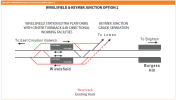What good is a frequent service beyond Haywards Heath (which is already 10tph today) when Eastbourne - Haywards Heath is only 2tph anyway? You've made people's journeys slower and less direct without a gain in frequency. What gain are those passengers' sacrifices intended to achieve?
Combining the East Grinstead services with the Eastbournes would enable you to combine their frequencies. Say 2tph to Eastbourne + 4tph to East Grinstead becomes 6tph to Eastbourne via East Grinstead. Eastbourne's frequencies go up, meaning the average journey time to London for someone arriving to Eastbourne at an arbitrary time will go down dramatically due to the increased frequency.
Other than wanting to draw a lot of criss-crossing lines on a map with a crayon, what problem is it you are trying to solve with your solution?
Improved connectivity, combining services to make better use of paths in London, increasing frequency to Eastbourne, and potentially freeing up paths for more services to Brighton.
You end up with a mess of a network which becomes a liability.
I think you may be somewhat over-egging the pudding a tad here, good sir.
While the BRPS want the railways as a whole to flourish, they are particularly interested in *their* railway and accepting NR trains onto their network would be a significant financial risk to them if they are required to operate a full-spec modern railway not a 'train set'.
I was thinking more they are suitably compensated and the line is bought off them and returned to the national network.
Uckfield to Lewes misses out the congested bit of Balcombe Tunnel Junction to Keymer Junction, so the longer journey times is acceptable because you are freeing up other useful capacity.
Four tracking Keymer Junction to Copyhold Junction frees up all the same paths as the lines become potentially operationally segregated.
ATM trains to East Grinstead are all stations from Sanderstead to EG. There journey time difference between Stopping and non-stopping trains is such that trying to run any non-stopping extras at 2tph would lead them to catch up the trains in front. Then they'd have to be in different paths across Selhurst Jns and up the fasts.
Adjust the timetables and flight them, then. I'm sure a solution could be found. There's a lot of double track railways out there that manage to mix fast and stopping services.
Have a gander at the old 2015 Sussex Area Route Study. Obviously it's somewhat outdated now, but the analysis and proposals show the various interventions that are likely to be needed in the future, and what they may look like. NR believe an additional 6tph will be needed, and to achieve that they wanted to build the southern part of what I'm proposing (it's what initially got me musing, actually):

...but it's all just part of a a package of interventions, so things like the Windmill Bridge remodelling and extra platforms at East Croydon would also all be needed.
For reference, London Victoria to Eastbourne is scheduled to take 44 minutes to HHE with stops at Clapham Jn, East Croydon and Gatwick Airport. London Victoria to East Grinstead is timetabled for 60 minutes with all stops from Sanderstead. The current stopping pattern takes 27.5 minutes from Windmill Bridge Jn to Hurst Green. An Uckfield train calling ECR, Oxted and HG only does it in 19 minutes. The difference will be worse if the East Grinstead - HG portion is considered as well.
But it serves a corridor far more people from the East Sussex coast actually want to travel!
I'm not saying don't do it, I'm saying do both, as they solve different problems. NR had some interesting things to say on the concept in the
2015 study I referenced above. Well worth a read.
It'll be very good radial route to Brighton for the places that don't currently have one, and offer direct services to London to an area of Brighton that doesn't have it, which includes several university campuses and a major stadium.
They wouldn't be direct services to London from east Brighton unless you propose somehow smashing though a chunk of Cliffe High Street to restore the later direct high-level line, bypassing Lewes entirely to the north, or building the rather elegant southern loop someone concocted the proposal for many years ago. None of which would be cheap.

